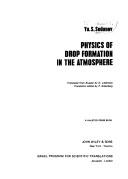| Listing 1 - 9 of 9 |
Sort by
|
Book
ISBN: 0470984600 9780470984604 Year: 1974 Publisher: New York (N.Y.): Wiley,
Abstract | Keywords | Export | Availability | Bookmark
 Loading...
Loading...Choose an application
- Reference Manager
- EndNote
- RefWorks (Direct export to RefWorks)
Atmosphere --- Infrared radiation --- Meteorological optics --- Ionospheric radio wave propagation --- 621.371.33 --- Atmospheric optics --- Optics, Meteorological --- Atmospheric physics --- Radio meteorology --- Radio wave propagation --- Infra-red rays --- Infrared rays --- Radiation, Infrared --- Rays, Infrared --- Electromagnetic waves --- Meteorology --- Propagation by indirect radiation with interposed reflection, refraction or diffraction. Propagation beyond the horizon --- Atmosphere. --- Infrared radiation. --- Ionospheric radio wave propagation. --- Meteorological optics. --- 621.371.33 Propagation by indirect radiation with interposed reflection, refraction or diffraction. Propagation beyond the horizon --- Atmospheric science

ISBN: 0470771119 0706513835 9780706513837 9780470771112 Year: 1974 Publisher: New York: Wiley,
Abstract | Keywords | Export | Availability | Bookmark
 Loading...
Loading...Choose an application
- Reference Manager
- EndNote
- RefWorks (Direct export to RefWorks)
Book
Year: 1970 Publisher: Jerusalem : Israel program for scientific translations,
Abstract | Keywords | Export | Availability | Bookmark
 Loading...
Loading...Choose an application
- Reference Manager
- EndNote
- RefWorks (Direct export to RefWorks)
Book
Year: 1974 Publisher: Jerusalem : Israel program for scientific translations,
Abstract | Keywords | Export | Availability | Bookmark
 Loading...
Loading...Choose an application
- Reference Manager
- EndNote
- RefWorks (Direct export to RefWorks)
Book
Year: 1969 Publisher: Jerusalem Israel Program for scientific translations
Abstract | Keywords | Export | Availability | Bookmark
 Loading...
Loading...Choose an application
- Reference Manager
- EndNote
- RefWorks (Direct export to RefWorks)
Book
ISBN: 0706514424 Year: 1974 Publisher: Jerusalem : Israel program for scientific translations,
Abstract | Keywords | Export | Availability | Bookmark
 Loading...
Loading...Choose an application
- Reference Manager
- EndNote
- RefWorks (Direct export to RefWorks)
Book
Year: 1970 Publisher: Jerusalem : Israel program for scientific translations,
Abstract | Keywords | Export | Availability | Bookmark
 Loading...
Loading...Choose an application
- Reference Manager
- EndNote
- RefWorks (Direct export to RefWorks)
Book
Year: 2015 Publisher: Washington, D.C., The World Bank,
Abstract | Keywords | Export | Availability | Bookmark
 Loading...
Loading...Choose an application
- Reference Manager
- EndNote
- RefWorks (Direct export to RefWorks)
This paper explores the link between exports and total factor productivity in Brazilian manufacturing firms over the period 2000-08. The Brazilian experience is instructive, as it is a case of an economy that expanded aggregate exports significantly, but with stagnant aggregate growth in total factor productivity. The paper first estimates firm-level total factor productivity under alternative assumptions (exogenous and endogenous law of motion for productivity) following a GMM procedure. In turn, the analysis uses stochastic dominance techniques to assess whether the ex ante most productive firms are those that start exporting (self-selection hypothesis). Finally, the paper tests whether exporting boosts firms'total factor productivity growth (learning-by-exporting hypothesis) using matching techniques to control for the possibility that selection into exports may not be a random process. The results confirm the self-selection hypothesis and show that starting to export yields additional growth in total factor productivity that emerges since the firm's first year of exporting but lasts only one year. Further, this extra total factor productivity growth is much higher under the assumption of an endogenous law of motion for productivity, which reinforces the importance of accounting for firm export status to study the evolution of productivity.
Education --- Industry --- Macroeconomics and Economic Growth --- Private Sector Development --- Social Protections and Labor
Book
Year: 2015 Publisher: Washington, D.C., The World Bank,
Abstract | Keywords | Export | Availability | Bookmark
 Loading...
Loading...Choose an application
- Reference Manager
- EndNote
- RefWorks (Direct export to RefWorks)
This paper explores the link between exports and total factor productivity in Brazilian manufacturing firms over the period 2000-08. The Brazilian experience is instructive, as it is a case of an economy that expanded aggregate exports significantly, but with stagnant aggregate growth in total factor productivity. The paper first estimates firm-level total factor productivity under alternative assumptions (exogenous and endogenous law of motion for productivity) following a GMM procedure. In turn, the analysis uses stochastic dominance techniques to assess whether the ex ante most productive firms are those that start exporting (self-selection hypothesis). Finally, the paper tests whether exporting boosts firms'total factor productivity growth (learning-by-exporting hypothesis) using matching techniques to control for the possibility that selection into exports may not be a random process. The results confirm the self-selection hypothesis and show that starting to export yields additional growth in total factor productivity that emerges since the firm's first year of exporting but lasts only one year. Further, this extra total factor productivity growth is much higher under the assumption of an endogenous law of motion for productivity, which reinforces the importance of accounting for firm export status to study the evolution of productivity.
Education --- Industry --- Macroeconomics and Economic Growth --- Private Sector Development --- Social Protections and Labor
| Listing 1 - 9 of 9 |
Sort by
|

 Search
Search Feedback
Feedback About UniCat
About UniCat  Help
Help News
News